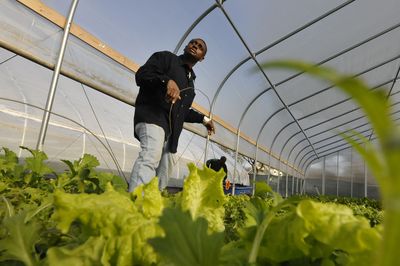Growing a green-collar economy
Rust Belt cities look for alternative types of business

CHICAGO – The lot where Isaac Wright Jr., ex-con, tends vegetables next to abandoned railroad tracks and across the street from a boarded-up house is the intersection of social justice, environmental righteousness and economic prosperity.
He is part foot soldier, part guinea pig in a movement that starts in the Englewood, Ill., garden and may reach all the way to the Oval Office, although he may not fully appreciate it.
“I’m not going to lie to you,” Wright said one crisp morning while working a row of radishes in a greenhouse. “I needed a job. Long as I was plugged in somewhere, that was OK.”
Wright works for Growing Home Inc., which offers “social business enterprise” job training for low-income people. It and he are part of the “green-collar economy,” a movement toward an environmentally sound, robust economy with a vast array of jobs, some of which are rooted in withering small towns or devastated inner cities.
Experts say Chicago, Rust Belt capital, provides the most fertile environment for the green-collar economy. The city’s New Energy for America plan calls for investing $150 billion over the next decade to create 5 million new “green jobs.”
“I just think Chicago is the symbol of what a green-collar renaissance can look like,” said Van Jones, founder and president of Green for All, a national nonprofit working to build “an inclusive, green economy” that would lift people from poverty.
The green-collar economy includes weatherizing and retrofitting buildings; manufacturing and maintaining wind turbines and hybrid vehicles; constructing and operating solar, wind and wave farms; and planting and caring for trees and organic food.
It would require entry-level, hard-hat jobs and “middle-skill jobs” in water management, mass transit, materials reuse and recycling, among others. Biologists, agricultural scientists, engineers and lawyers also would be needed.
When Jones and other advocates frame it as a solution to an ailing economy, a tainted environment and social injustice, the green-collar economy can fan a near-frenzy of excitement. But even advocates concede that hope, fueled perhaps by desperation for a shred of optimism, has gotten a little carried away.
Skeptics say it’s too costly for the benefits. Both sides agree that the green-collar economy needs a strong push from the federal government, an uncertain prospect in a deep recession.
For now, an October report by the U.S. Conference of Mayors estimates that about 750,000 jobs are related to the “green sector,” in industries such as renewable power and fuels, agriculture and building retrofitting. Fueled by concern about global warming; the untapped potential of and growing demand for alternative energy; growth in “green” construction; and the current stock of energy-inefficient buildings, that number is expected to grow to more than 2.5 million by 2018, the report states.
“Elected officials at all levels of government and private markets are both gearing up for massive investments in new alternative-fuel technologies and in increased energy efficiency,” the report states. “Market forces, legislation and local initiatives, or some combination thereof,” will yield high growth among green-collar jobs.